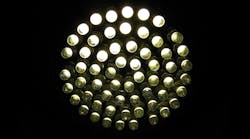With newly developed technology, accessing wireless networks nearly 100 times faster than Wi-Fi could be as simple as switching on a light bulb. That technology, known as Li-Fi or light fidelity, involves encoding data into visible light instead of the radio waves used by traditional wireless technology like Wi-Fi.
Though Li-Fi has been largely confined to research labs, several new products have begun to leak out of laboratories. These products appeared in the shadowed corners of this year's Mobile World Congress in Barcelona, while most of the wireless industry focused on fifth-generation, or 5G, wireless technology. PureLiFi, one of the earliest companies to develop Li-Fi products, presented a new dongle for computers and laptops. In addition, the French startup Oledcomm demonstrated its Internet lighting system for offices and hospitals.
Li-Fi takes advantage of the fact that light-emitting diodes (LEDs) used in light bulbs are semiconductor devices. The same electric current sent through them to produce light can be switched at extremely fast speeds, flickering the light to encode parallel data streams. Though the flickering is imperceptible to the human eye, it works almost like a digital version of Morse code.
When an LED is combined with signal processing technology, it can send data into photo detectors built into smartphones, dongles, and other devices. It works on a similar principle as remote controls, which use infrared light to send tiny data streams to televisions and toys. But visible light can reach intensities that capture much larger amounts of data. Researchers have used these properties to create Li-Fi networks with download speeds over 200 gigabits per second.
“All we need to do is fit a small microchip on every potential illumination device and this would combine two basic functionalities: illumination and wireless data transmission,” said Harald Haas, a professor of mobile communications at the University of Edinburgh, during his first TED Talk in 2011, in which he introduced the term Li-Fi.
Less than a year after his initial demonstration in 2011, Haas spun out pureLiFi from his research at the University of Edinburgh. The company recently unveiled LiFi-X, which includes an access point that connects to LED bulbs and a dongle that provides 40 Mbits/s downloads and uploads. Earlier pureLiFi products delivered only a fourth of the throughput, making it comparable to early versions of Wi-Fi.
The widespread growth of LED lighting, combined with the largely untapped visible spectrum, have inspired a wave of new startups. Last year, the Estonian company Velmenni tested Li-Fi technology in the field with speeds around 1 Gbit/s. For its part, Oledcomm sells development kits for building Li-Fi into devices. Others, like ByteLight, have focused on using visible light communications to build systems for supermarkets and retail stores, allowing customers to use smartphone apps to find products.
Larger companies like Philips Lighting are investigating the technology to help build out smart cities and smart buildings. Thus far, most Li-Fi products have targeted houses, businesses, offices, and even hospitals, where interference with medical equipment is a concern. But startup companies have begun to point out that Li-Fi would be ideal for the Internet of Things (IoT), linking low-power sensors in industrial equipment or home appliances.
Deepak Solanki, chief executive of Velmenni, said in an interview with Agence France-Presse that new devices with gigabit Li-Fi technology are still around two or three years out. He noted that while an existing LEDs were widely available, retrofitting these lights for Li-Fi would be problematic.
Most analysts envision Li-Fi as a supplement to Wi-Fi rather than a replacement. One reason is that Li-Fi only works with devices in the light. Naturally, it also cannot travel through walls like Wi-Fi and other wireless technologies—though it supporters maintain that this translates into tougher security. As for the Internet of Things, a new version called Wi-Fi HaLow boasts lower power consumption and more effective penetration through through walls and other obstacles.
These arguments seem like a moot point for Haas. Merging light bulbs and wireless communications is not about displacing older technologies but about recognizing the role of wireless technology in our lives. “Wireless communications has become a utility like electricity and water,” he notes.


